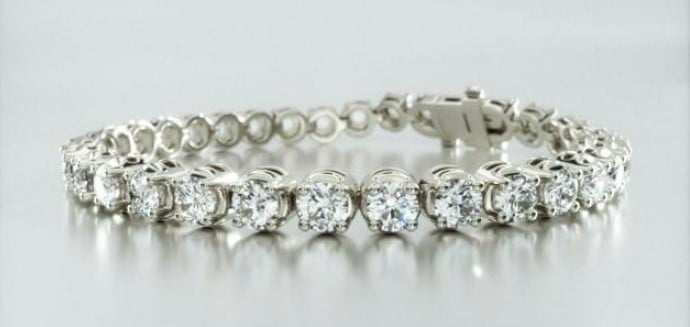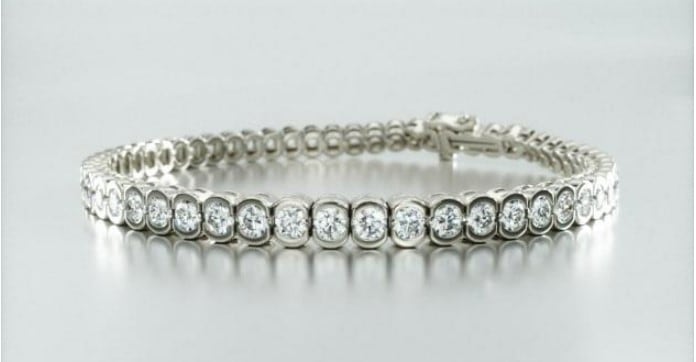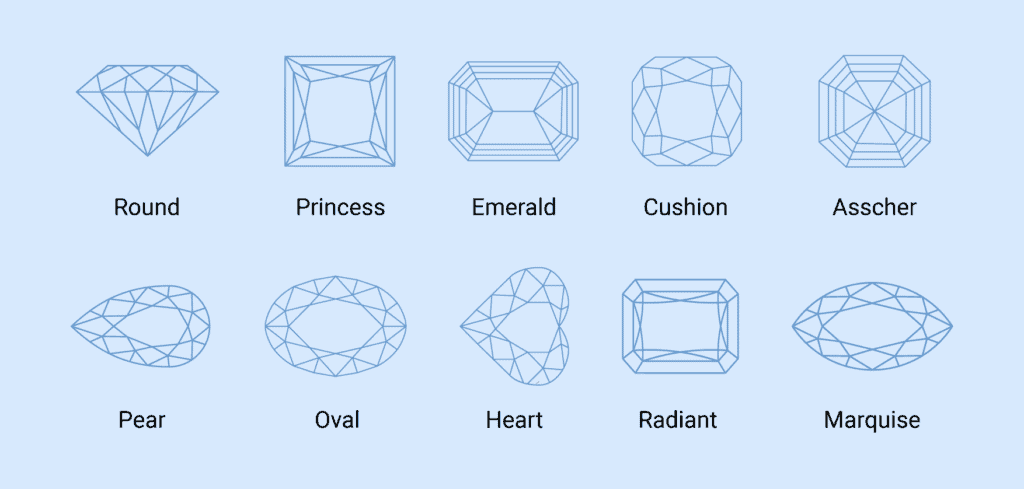We are reader-supported. Buying through any red colored link on our site may earn us commissions. Learn More.
Up to 30% off engagement rings and select jewelry at James Allen!
A lab-grown diamond tennis bracelet is a timeless piece of jewelry featuring a single or multiple rows of lab-created diamonds set in a straight line. These diamonds are not mined but are instead created in a laboratory setting, making them an ethical and often more affordable choice without compromising on brilliance or quality.
Whether you’re looking for a bracelet for your wedding day or a special event, a lab-grown diamond tennis bracelet can offer brilliance and style. Lab-grown diamonds are less expensive than mined diamonds and look identical. Designs range from classic tennis bracelets to modern styles with colored diamonds. In this guide, we cover the best lab-grown diamond tennis bracelets, how much they cost, and where to shop.
The price for a lab grown tennis bracelet can vary from $1,200 for a 1 CTW to as high as $10,000 for a 10 CTW bracelet. Prices vary based on factors like total carat weight, the kind of precious metal used, and the design style.
Here’s what we’ll cover in this article:
What is a lab-grown diamond tennis bracelet?
What’s the price for a lab-grown diamond tennis bracelet?
Where can I buy the best lab-Grown Diamond Tennis Bracelets?
How do I choose the perfect lab-grown diamond tennis bracelet?
What’s the difference between Moissanite vs. lab diamond tennis bracelets?
How do I choose the right size?
Why you should trust us
What is a lab-grown diamond tennis bracelet?
Lab-grown diamond tennis bracelets are thin bracelets with a symmetrical pattern of lab-grown diamonds forming a complete circle. They’re typically made of gold, platinum, or sterling silver. Lab-created diamonds are made in a laboratory, but share the same chemical, optical, and physical properties as mined diamonds.
Why is it called a tennis bracelet? During the 1987 US Open, tennis champion Chris Evert lost her eternity bracelet on the court. In media interviews, Chris referred to it as her “tennis bracelet,” and the name stuck.
How much does a lab-grown diamond tennis bracelet cost?
The average cost of a 1 carat lab-grown diamond tennis bracelet is $1,200. Lab-grown diamond tennis bracelets range from $700 to $17,000 depending on the total carat weight, type of precious metal, and style.
The cost of a 10-carat lab-grown tennis bracelet falls between $5,000 and $17,000 depending on the quality of the stones and the precious metal.
In general, lab-grown diamonds cost 30-50% less per carat than mined diamonds of the same quality.
Top lab-grown diamond tennis bracelets
From various designs and colors to diamond shapes and settings, here are our picks of lab-grown diamond tennis bracelets. Prong, bezel, and channel settings are the most popular, while diamond shapes range from round cuts to princess cuts.
Classic lab-grown diamond tennis bracelets
Four-Prong Round Tennis Bracelet

Shimmering from end to end, this timeless tennis bracelet features 34 round cut diamonds. The perfect addition to any ensemble, this bracelet is bound to turn heads.
Basket Prong Diamond Tennis Bracelet

The basket prongs in this bracelet give space between each diamond, allowing plenty of light to hit each stone.
Modern Lab Grown Diamond Tennis Bracelets
Bezel Lab Created Diamond Tennis Bracelet

With an exquisite row of lab-created diamonds, this bezel setting bracelet offers maximum security for the diamonds without sacrificing style.
Vintage Lab Grown Diamond Tennis Bracelets
Emerald Cut Diamond Tennis Bracelet

Truly royal in style, this emerald cut bracelet glimmers like a hall of mirrors. With 59 diamonds, this bracelet is sure to become an heirloom piece.
Related Article: Lab-Created Diamond Pendants: Buying Guide
How to choose the perfect lab-grown diamond tennis bracelet
Finding the best lab-grown diamond tennis bracelet means keeping an eye on a few important details, such as diamond quality and metal.
Lab Diamond Tennis Bracelet Cut, Clarity, and Color
The quality of the diamonds, including their cut, color, and clarity, impact how brilliant and eye-catching your tennis bracelet is. In general, aim for a minimum color of H or better for diamond tennis bracelets and clarity of SI1 or better.
Keep in mind that for bracelets with a total carat weight of 5 or less, the 4Cs of diamonds don’t matter as much as they do for an engagement ring. The stones are simply too small to notice imperfections.
Lab Diamond Carat Weight
Lab-grown diamond tennis bracelets range from 1 carat to 15-carat total weight (or more). Determine what’s in your budget, but also compare what style you like the best. You may not want a thick tennis bracelet, but instead one with a more delicate appearance and smaller stones. Bigger isn’t always better.
Lab Diamond Shape
Diamond tennis bracelets can feature round diamonds for a classic look or other shapes such as princess cut and oval cut diamonds. Look at a range of shapes on tennis bracelets to see what appeals to you the most.

Precious Metal
14K and 18K gold have more durability and longevity than sterling silver while being more affordable than platinum. You can choose between rose gold, yellow gold, and white gold. If you want a contrasted look, opt for yellow gold or rose gold. For a more understated but classic appearance, white gold is the way to go.
Comfortable Fit
You want your bracelet to fit you securely but not be uncomfortable. You don’t want it too tight or to feel like it’s going to roll off your wrist. Measure your wrist before ordering your bracelet so you don’t have to worry about sending it back for a different size. Find more details in our tennis bracelet size guide below.
Diamond Certifications
Diamond certifications matter when you’re buying a center stone for an engagement ring or a large diamond pendant. But for tennis bracelets, with 30 or more diamonds, the cost of getting certifications for each stone isn’t worth it (or necessary).
Vetted Vendor
You want a diamond bracelet that is well-made and holds up for years to come. Be sure you shop with a reputable vendor such as Blue Nile or James Allen. These vendors offer well-crafted jewelry at competitive prices. They’re also known for their excellent customer service and return policies.
Price
Put together an idea of what you’d like to spend on a tennis bracelet then compare prices at various vendors. Look at different carat weights and styles to see what fits your budget. Be sure to focus on the quality of the bracelet and diamonds overcarat weight. A stunning, well-made bracelet with a 3-carat total carat weight is far more beautiful and eye-catching than a faulty, cheaply-made 5-carat bracelet.
Related Article: Diamond Studs: Buying Guide
Moissanite vs. lab diamond tennis bracelets
Moissanite is a colorless gemstone composed of silicon carbide and is distinct from a lab-created diamond. It doesn’t have nearly the same brilliance as lab-grown or mined diamonds. They are duller than diamonds and give off a more rainbow-sparkly light. A lot of moissanite stones tend to resemble a K on the color scale, meaning they have a brown or yellow tint to them. Stick to a lab-created diamond for beautiful brilliance and fire.
Tennis Bracelet Size Guide
Your tennis bracelet should fit securely on your wrist, and not be too tight or too loose. While bracelet sizes don’t matter as much as ring sizes (which should be an exact fit), aim to get as close as you can for both comfort and security.
- Measure your wrist with a piece of yarn or ribbon.
- Cut the ribbon or yarn to the length of your wrist’s circumference.
- Measure the cut piece of yarn or ribbon with a ruler or tape measure.
- Add a half inch or one inch to your measurement to calculate your bracelet size. If your wrist measures six inches, consider a 6.5 to 7-inch bracelet depending on how loose you’d like the fit.
The most popular bracelet sizes for women are 7 and 7.5, so consider these as a starting point if you’re unsure.
FAQs About Lab-Grown Diamond Bracelets
Tennis bracelets usually have between 30 and 110 diamonds, depending on the size of the diamond and the setting of the bracelet. Tennis bracelets range in style, size, shape, and design. More diamonds don’t always mean better. The bracelet you choose depends on your personal style and what you like the best.
A tennis bracelet can be anywhere from 1 carat in total carat weight to 15 carats or more. The total carat weight you choose depends on your budget and style desires, whether you want to have large diamonds or a more subtle look.
Experts to Help With Your Selection
If you’d like an expert opinion on a tennis bracelet, send a note to our experts. We’ll help you sort through options and select a stunning tennis bracelet that brings joy for years to come.
Here are more lab-grown topics to browse:
- What is a lab-grown / man-made / synthetic diamond?
- What is the price range of lab-grown diamonds?
- What are the differences between lab-grown vs. natural diamonds?
- Where is the best place to buy lab-grown diamonds?
- Does GIA or IGI certify lab-grown diamonds?
- How to use a lab-grown diamond color chart?
- What is the best lab-grown diamond clarity (chart + scale)?
- What is the difference between CVD vs. HPHT lab diamonds?
- What are the best lab-grown diamond stud earrings?
- Where is the best place to buy lab diamond pendants?
- What is the price of yellow lab-grown diamonds?
- What is the price of pink lab-grown diamonds?

- No questions asked returns within 30 days of shipment. James Allen will send you a paid shipping label to return the ring.
- Lifetime Warranty
- Free International Shipping
- Free prong tightening, repolishing, rhodium plating and cleaning every 6 months
- Provide insurance appraisals
- One free resizing within 60 days of purchase
- Free ring inscriptions
- Best-in-class high quality imagery of all diamonds in stock
- 24/7 Customer Service
- Best-in-class packaging


- No questions asked returns within 30 days of shipment. Blue Nile will send you a paid shipping label to return the ring.
- Lifetime Warranty
- Free Shipping
- Free prong tightening, repolishing, rhodium plating and cleaning every 6 months
- Provide insurance appraisal
- One free resizing within the first year of purchase
- High quality images of about half of their diamonds
- 24/7 Customer Service
- 100% credit towards future upgrades (must be at least double in value)
- Best in class fulfillment

Still afraid of getting ripped off?
Before you buy a diamond, get personal buying advice from industry veterans. We'll help you get the best diamond for the money.
Ask your diamond purchase question here
DISCLAIMER: We don't use your email for marketing. Period.
You Might Like
Diamond Prices: A Complete Guide
A diamonds’ price is determined primarily by the 4 Cs of the diamond. On the wholesale level, diamond prices are first based on a diamond shape and
The Best Places to Buy Engagement Rings
Buying an engagement ring is often one of the first major purchases in a person's life. The process can be fraught with tension as there are so m
1 Carat Diamond Price & Buying Guide
A wide range of 1 carat diamonds exist both in online markets and local diamond jewelry stores. Not only are there significant differences in beauty

